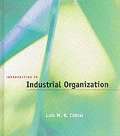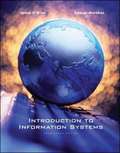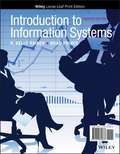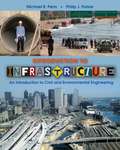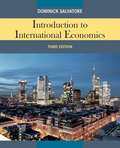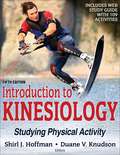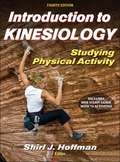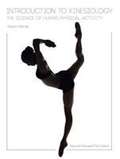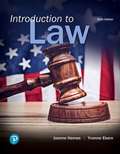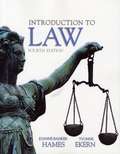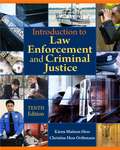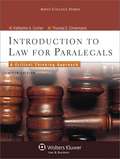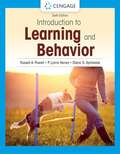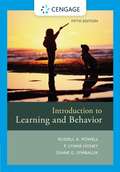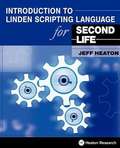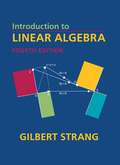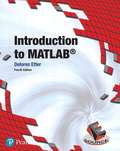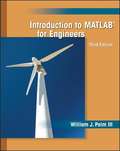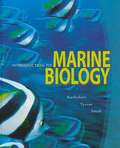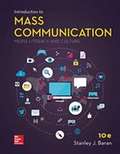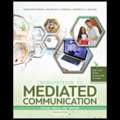- Table View
- List View
Introduction to Industrial Organization
by Luís M. B. CabralOver the past twenty years, the study of industrial organization--the analysis of imperfectly competitive markets--has grown from a niche area of microeconomics to a key component of economics and of related disciplines such as finance, strategy, and marketing. This book provides an issue-driven introduction to industrial organization. It includes a vast array of examples, from both within and outside the United States. While formal in its approach, the book is written in a way that requires only basic mathematical training. Supplemental materials posted on the Web make more extensive use of algebra and calculus.
Introduction to Information Systems (14th edition)
by James A. O'Brien George M. MarakasO'Brien's Introduction to Information Systems 14e continues to reflect the movement toward enterprise-wide business applications. George Marakas from the University of Kansas joins as a co-author on this new edition. New real world case studies correspond with this curriculum shift. The texts focus is on teaching the general business manager how to use and manage the most current IT technologies such as the Internet, Intranets, and Extranets for enterprise collaboration, and how IT contributes to competitive advantage, re-engineering business processes, problem solving, and decision-making.
Introduction to Information Systems: Seventh Edition
by R. Kelly Rainer Casey G. CegielskiThe goal of Introduction to Information Systems is to teach undergraduate business majors how to use information technology to master their current or future jobs. Students develop a working understanding of information systems and information technology and learn how to apply concepts to successfully facilitate business processes. This product demonstrates that IT is a key component of any business, whether a student is majoring in Accounting, Finance, Marketing, Human Resources, or Production/Operations Management.
Introduction to Infrastructure: An Introduction to Civil and Environmental Engineering
by Philip J. Parker Michael R. PennIntroduction to Infrastructure: An Introduction to Civil andEnvironmental Engineering breaks new ground in preparingcivil and environmental engineers to meet the challenges of the21st century.
Introduction to International Economics (Third Edition)
by Dominick SalvatoreThe aim of this text is to provide the student with an introduction to the field of international economics using many real-world case studies.
Introduction to Kinesiology: Studying Physical Activity
by Shirl Hoffman Duane Knudson<p>The text features the three-section structure that has always been a strength of this leading introductory textbook. Part I examines the diversity of physical activity and kinesiology and summarizes the importance of knowledge gained through physical activity experiences. Part II delves into the seven major subdisciplines of kinesiology, with an overview of major historical events, research methods, professional work and application, and ideas for career advancement in each. Part III elaborates on professionalism and then examines five main areas for career opportunities. <p>The extensive and revitalized instructor ancillaries include an instructor guide, a test package, chapter quizzes, a presentation package, and an image bank that includes most art and tables from the text. <p>Introduction to Kinesiology provides basic and essential information for students embarking on their study of kinesiology, and this updated fifth edition prepares them for future courses and further study.</p>
Introduction to Kinesiology: Studying Physical Activity
by Shirl J. HoffmanIntroduction to Kinesiology: Studying Physical Activity, Fourth Edition, is the most cohesive introduction to the field of kinesiology available, demonstrating how its many disciplines integrate into a unified body of knowledge. This all-inclusive approach gives students a solid background in the field and prepares them for further study and course work. This engaging and jargon-free text also introduces students to job prospects and areas of study and professional practice in kinesiology. Introduction to Kinesiology, Fourth Edition, orients and prepares students for in-depth studies in their areas of interest. Its broad scope acknowledges students' diverse interests and aspirations in professional and scholarly career tracks as well as teaching and coaching. Top kinesiologists expand discussion of physical activity beyond exercise, sport, or health-related activity in an effort to broaden conceptions of physical activity and the potential contributions of kinesiology. The contributors, each with specific expertise in the subdisciplines, share their perspectives in chapters complemented by full-color photos and illustrations.
Introduction to Kinesiology: The Science of Human Physical Activity
by Mitchell MarilynIntroduction to Kinesiology: The Science of Human Physical Activity outlines the major concepts, principles, and experimental findings for the curious yet serious student interested in the field of kinesiology. Like most fields of science, it is important to provide kinesiology students with a textbook that covers the historical development of the field, discusses career opportunities, and provides the groundwork for future coursework. It is also important to clearly articulate the limit and scope of kinesiology by defining core knowledge and to emphasize the cross-disciplinary nature of kinesiology. Introduction to Kinesiology was designed to meet all of these requirements.
Introduction to Labour and Industrial Laws
by Dr Avtar Singh Prof Dr Harpreet KaurIntroduction to Labour and Industrial Laws by Avtar Singh offers a comprehensive overview of key principles governing employment and industrial relations in India. The book covers major labour legislations, including laws on wages, working conditions, social security, and trade unions. It explains the evolution and objectives of labour laws in a clear, accessible manner. Special focus is given to the rights and duties of employers and employees within the legal framework. Ideal for law students and professionals, it bridges theoretical understanding with practical application.
Introduction to Landscaping: Design, Construction, and Maintenance (3rd Edition)
by Charles B. Schroeder Ronald J. BiondoLandscaping is one of the fastest growing segments of the horticulture industry. Introduction to Landscaping: Design, Construction, and Maintenance offers a practical approach to establishing and maintaining residential landscapes. It introduces the various aspects of the landscape industry to students of horticulture and agriculture from a horticultural perspective. This book has been organized in three distinct parts--landscape design, landscape construction, and landscape maintenance.
Introduction to Law
by Joanne Banker Hames Yvonne EkernIntroducing students to the system, principles, and concepts of law: Introduction to Law guides students through the beginnings of their law education, using premium features to explore basic legal concepts related to substantive and procedural law. Students are exposed to cases, statutes, regulations, and the Constitution, while developing their legal vocabulary, critical thinking skills, and ability to read cases. All chapters of the 6th edition have been reviewed, edited, and updated to reflect current law and legal forms and to provide additional activities illustrating real-world applications of legal practices.
Introduction to Law (4th Edition)
by Joanne Banker Hames Yvonne EkernThis 4th edition aims to teach U.S. students the basic concepts related to substantive and procedural law, introduces them to cases, statutes, and the constitution, and develops their legal vocabulary and analytical skills. It contains a new chapter on constitutional law and expanded coverage of employment and environmental law.
Introduction to Law Enforcement and Criminal Justice (Tenth Edition)
by Kären M. Hess Christine Hess OrthmannINTRODUCTION TO LAW ENFORCEMENT AND CRIMINAL JUSTICE, 10th edition provides readers with comprehensive information on both law enforcement and the criminal justice system, all in one convenient book. This very practical, applied book not only examines the role of police within the larger criminal justice system but it also introduces readers to the other components of that system such as the courts, corrections, and juvenile justice. INTRODUCTION TO LAW ENFORCEMENT AND CRIMINAL JUSTICE, 10th edition has a uniquely accessible writing style with many real-world examples and has a "boots on the street" perspective. This new edition includes an extensive discussion of data-driven strategies and policing, such as CompStat policing, intelligence-led policing and evidence based policing. Readers will also learn about controversies surrounding immigration law enforcement and several new Supreme Court cases affecting law enforcement and the criminal justice system.
Introduction to Law for Paralegals: A Critical Thinking Approach (5th Edition)
by Thomas E. Eimermann Katherine A. Curriera comprehensive and accessible text, specifically written for paralegal students, Introduction to Law for Paralegals provides an in-depth introduction to the key concepts in the American legal system, research and analysis of legal material, as well as legal ethics and substantive law. Supported by strong pedagogy and a critical-thinking approach to edited cases, the material is engaging, well-written and highly teachable. the Fifth Edition has been updated to reflect new cases and changes in statutory law, with new reasoning exercises to challenge and engage students. Updated Internet references and Web-based exercises are also included. The rich Appendix now includes the full text of the U. S. Constitution. Features:Comprehensive, accessible overview of all key concepts covered in an introduction to law course. Highly teachable style, with detailed Instructor's Manual, TestBank and PowerPoints. In-depth coverage written specifically for paralegal students,including:the role of the paralegal. Sources and classification of law. Structure of the court system. Overview of litigation Basics of legal analysis, research, and writing. Legal ethics and substantive law. Critical-thinking approach introduces students to the study of law. Use of edited cases to teach students how to read and analyze the law. Engaging hypotheticals, examples, and well-designed question s. Material presented in organized and well-written format. Strong pedagogy throughout includes:Ethic alerts. Marginal definitions. Internet references. Legal reasoning exercises. Appendices on good writing, citation form, ethical codes and Netnotes. Thoroughly updated, the revised Fifth Edition includes:Streamlined presentation. New cases and changes in statutory law. New Web-based exercises. Updated Internet references throughout. New legal reasoning exercises reflecting current cases. Complete U. S. Constitution as an appendix.
Introduction to Learning and Behavior
by Russell A. Powell P. Lynne Honey Diane G. SymbalukGain a clear understanding of the basic principles of learning and behavior and how you can apply this information to better understand and improve today's world with Powell, Honey, and Symbaluk's INTRODUCTION TO LEARNING AND BEHAVIOR, 6E. This engaging, student-friendly behavioral approach to psychology uses examples derived from both animals and humans to vividly illustrate the relevance of behavioral principles in comprehending and impacting human behavior. Updated, expanded coverage and a dedicated appendix address self-control and behavior self-management in detail with specific tactics you can immediately apply. "Study Tip" guide you in strategies, from effectively reading texts to using procedures to increase concentration and reduce procrastination. You also see how principles apply to managing relationships and raising children. Numerous innovative and updated review, self-testing, learning and independent study features further your understanding of key concepts.
Introduction to Learning and Behavior
by Russell Powell P. Honey Diane Symbaluk Michele SordiINTRODUCTION TO LEARNING AND BEHAVIOR, 5th Edition provides you with a clear introduction to the basic principles of behavior presented in an accessible, engaging manner. Using examples derived from both animals and humans, the text vividly illustrates the relevance of behavioral principles to understanding and improving human behavior. The authors demonstrate the application of behavioral principles to such relevant issues as improving your study behavior, reducing procrastination, raising children, and managing relationships. To help you maximize your learning, the text is packed with innovative study and review tools to further your understanding of key concepts.
Introduction to Linden Scripting Language for Second Life
by Jeff HeatonThe Linden Scripting Language allows residents of the Second Life World to program the three dimensional objects around them. Without this programming objects built in Second Life are motionless and non-interactive. Adding a script enables an object to interact with the world around it. Second Life scripts allow objects such as cars, planes, amusement park rides, weapons and other entertainment devices to be created. This book teaches the beginning Second Life programmer to make use of the basics of the Linden Scripting Language. Language fundamentals, such as variables, loops, lists, events, functions and state machines are covered. The book then moves to more advanced topics such as user interaction and non-physical movement. Later chapters show how to use the Second Life physics engine to create vehicles.
Introduction to Linear Algebra (4th Edition)
by Gilbert StrangThis leading textbook for first courses in linear algebra comes from the hugely experienced MIT lecturer and author Gilbert Strang. The book's tried and tested approach is direct, offering practical explanations and examples, while showing the beauty and variety of the subject. Unlike most other linear algebra textbooks, the approach is not a repetitive drill. Instead it inspires an understanding of real mathematics. The book moves gradually and naturally from numbers to vectors to the four fundamental subspaces. This new edition includes challenge problems at the end of each section.
Introduction to Locomotor and Multiple Disabilities - TNOU (Course 4 / 03 #SED-16)
by Tamil Nadu Open UniversityThe course aims to develop understanding about planning effective educational programme and functional activities for students with locomotor and multiple disabilities. This course intends to develop required skills in teacher trainee to identify the children with locomotor and multiple disabilities and also plan an effective programme education as well as for creating awareness on these conditions. Teacher is also expected to plan an effective therapeutic and programme and also refer for medical intervention whenever if necessary.
Introduction to MATLAB
by Delores EtterThis book is appropriate for use as an introductory engineering text or as a supplemental text in an advanced course. It is also useful as a professional reference. The text will introduce engineering problem solving with the following objectives: (i) Present a consistent methodology for solving engineering problems; (ii) Describe the exceptional computational and visualization capabilities of MATLAB; and (iii) Illustrate the problem-solving process through a variety of engineering examples and applications. Throughout the text, emphasis is placed on incorporating real-world engineering and scientific examples with solutions and usable code. Each chapter ends with a Summary that reviews the topics covered and includes a list of Key Terms. A MATLAB Summary lists all the special symbols, commands, and functions defined in the chapter. Hints are provided to help the student avoid some of the common errors.
Introduction to MATLAB for Engineers
by William J. PalmIntroduction to MATLAB for Engineersis a simple, concise book designed to be useful for beginners and to be kept as a reference. The terminology, syntax, and the use of the programming language are well defined, and the organization of the material makes it easy to locate information and navigate through the textbook. The text covers all the major capabilities of MATLAB that are useful for beginning students.
Introduction to Marine Biology
by Richard Turner George Karleskint Jr. James W. Small Jr.NIMAC-sourced textbook
Introduction to Marine Biology, 3rd edition
by George Karleskint James W. Small Richard TurnerImmerse yourself in INTRODUCTION TO MARINE BIOLOGY and quickly learn the content of the course. While taking an ecological approach, this biology text provides succinct coverage of the content while the photos and art work clearly illustrates key concepts. Studying is made easy with phonetic pronunciations, a running glossary of key terms, end-of-chapter questions, and websites provided at the end of the chapter, and lists of related articles found throughout the text.
Introduction to Mass Communication
by Stanley BaranIn today’s media rich world Introduction to Mass Communication keeps media literacy and culture at its core. Using examples of the past to show how mass communications got their roots and keeping current with the present’s emerging technologies and trends Introduction to Mass Communication gives students a deeper understanding of the role media plays in both shaping and reflecting culture. By understanding and evaluating the ways in which media convergence is changing the landscape of media today students are encouraged to think critically about their own roles in society as active media consumers. Through this cultural perspective students learn that audience members are as much a part of the mass communication process as are the media technologies and industries. The tenth edition maintains its commitment to enhancing students’ critical thinking and media literacy skills. New and updated material such as the 2016 Presidential election and the use of social media to link fans with artists and their music reflects the latest developments in digital technologies and highlights the most current research in the field.
Introduction to Mediated Communication: Social Media and Beyond
by David Keith WestermanComputers allow us to do things today that were barely dreamed of 60 years ago. Today, computers and networks provide us a personal space in which we can share our innermost thoughts and feelings on a large network with others. <P><P> Introduction to Mediated Communication explains and discusses mediated communication through a functional approach - focusing attention on how people use computer technology to accomplish their communication functions. <P><P> Rather than focus on the nature of the medium itself and what sets it apart from more “traditional” media, Introduction to Computer Mediated Communication focuses on what functions people use technology for, and how people use technology to accomplish their multiple communication goals. By focusing on functions rather than channels, the publication provides instruction into the reason people use media, rather than simply discussing various technological products that will soon be outdated
